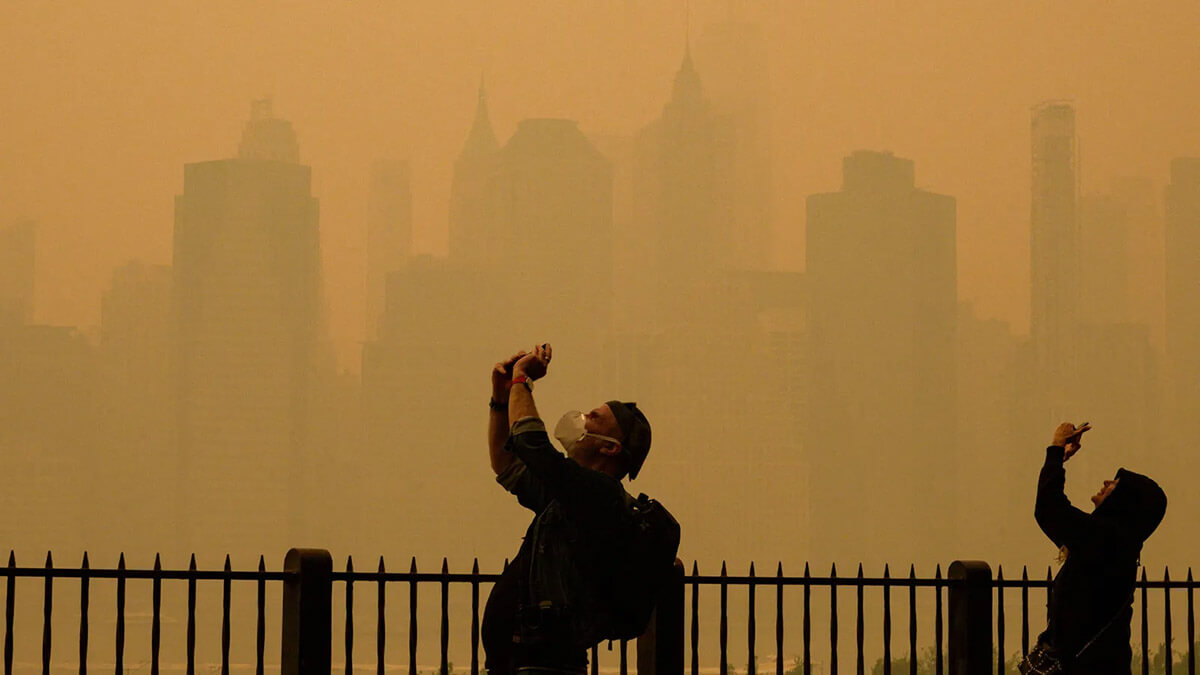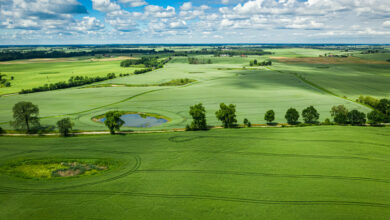“We need to look at wildfires as a public health problem” – Dr. Kim-Chi Tran
Contrary to the norm, the nightmare came early. Although the expected start of the fire season is May, Canada has been affected by an ongoing record-setting series of wildfires since March.
In addition to the unimaginable losses resulting from the millions of hectares of burned area, there is also the fact that thousands of people have been forced to leave their homes—at least temporarily—and the smoke migration phenomenon of these fires, which has led to deteriorating air quality, raised concerns about public health and safety, and caused masks to be worn once again.
New York City was covered in thick smoke, and Philadelphia, Washington DC and Minnesota were forced to declare a “code red” emergency, the highest category of the air quality index, which presupposes conditions dangerous to health—the index even surpassed that of the most polluted cities in the world.
Last Friday (9), the smoke crossed the Atlantic and reached Norway, albeit at low levels and weak density, which ruled out the possibility of an adverse effect on the population’s health.
But it doesn’t stop there: after gases and particles from these fires reached the Azores on Tuesday (13), these pollutants, mostly carbon monoxide transported and dispersed by winds in the atmosphere, are expected to reach the Iberian Peninsula on Sunday (18).
At a time when the situation is far from under control, there is growing concern about the effects the fires are having (or may have) on people’s health: not only physically, but also mentally. Speaking to Milénio Stadium, Dr. Kim-Chi Tran, co-founder and co-chair of the OMA Green is Health Medical Interest Group, says she has no doubt that forest fires should be seen as a public health problem, especially so that there is better preparation and response to events of this nature in the future.
Milénio Stadium: Smoke from wildfires in Canada has led several cities to achieve absolute and world records for air pollution: what are the known effects that exposure to it has on health, both in the short and medium to long term?
Dr. Kim-Chi Tran: Short term: We know that wildfire smoke will increase asthma exacerbations and difficulty breathing in those with chronic obstructive pulmonary disease (COPD). Studies have found that there are increased emergency room visits due to breathing difficulties, as well as hospitalizations (https://pubmed.ncbi.nlm.nih.gov/27082891/).
Medium term: Those exposed to air pollutants in pregnancy were more likely to have lower birth weight babies. (https://pubmed.ncbi.nlm.nih.gov/27082891/)
Long term: Children have a higher metabolic rate, meaning that they breathe more often and are more active than adults. A study done in China has shown that long term exposure to pollutants in developing lungs leads to lower lung function scores (https://www.ncbi.nlm.nih.gov/pmc/articles/PMC7656332/).
MS: In what other ways can such an event affect the physical health of citizens?
DKCT: There is evidence that exposure to air pollutants from smoke can cause an increase in lung infections and premature mortality (death). (https://pubmed.ncbi.nlm.nih.gov/27082891/) Research has looked into cardiac health events during wildfires (ex. heart attacks, heart failure, arrythmias), however data is currently inconclusive. (https://pubmed.ncbi.nlm.nih.gov/33413506/)
MS: But it is certainly not only physical health that will be damaged after such an event: what about mental health, what are the expected consequences?
DKCT: When they studied the number of emergency room visits during wildfires, the number of mental health visits during wildfire events did not increase, but this is not to say that mental health was not affected. (https://pubmed.ncbi.nlm.nih.gov/27082891/). Displaced populations, those with worsening health issues, are likely to experience more depression, anxiety, and perhaps even post-traumatic stress disorder. Alongside these issues, different people will have different coping mechanisms, and some of these could be unhealthy as well.
MS: How should people act to safeguard and mitigate the various impacts on their health?
DKCT: We must first recognize that wildfires will be more common and more severe due to climate change and global warming. We must all realize that we are all contributing to climate change, and a warmer planet leads to warmer and drier temperatures, which are unfortunately prime for forest fires. In doing our part to call out the fossil fuel industry we can safeguard not only our future, but the future of our children and grandchildren.
In keeping with this, we need to be aware of methods of forestry management – many of them conducted by indigenous populations for years – to safeguard and replenish our forest. Prescribed burns help to reduce wildfire intensity, and repopulate forests. (https://www.cbc.ca/news/science/what-on-earth-indigenous-fire-forests-1.6194999). These tried and true methods of limiting severe fires need to be readapted into our practices, with the wisdom of those who were here before us.
On a personal level, I would recommend that people stay indoors as much as possible when air pollution indices are high (with windows closed), and if feasible purchase reliable air filters. Outdoor activities should be limited, and if outside I would recommend wearing suitable facemasks (N95 or better, properly fitted) (https://pubmed.ncbi.nlm.nih.gov/36360613/).
MS: Which group of people is considered most vulnerable?
DKCT: The extremes of age are always the most vulnerable, and this consists of babies, young children, the elderly. Pregnant women, those with pre-existing heart and lung problems also are the first ones to suffer from the effects of smoke inhalation.
MS: What symptoms should people – both physical and mental – be aware of so that they can seek medical attention if they identify them?
DKCT: With initial symptoms of smoke inhalation people may suffer from dizziness, difficulty breathing, coughing, burning eyes, headache and nausea. Feelings of anxiety or depression may also be prevalent. Should either physical or mental symptoms worsen, I would recommend seeking professional medical help.
MS: Can we look at this whole scenario as a real public health problem?
DKCT: Absolutely. Back in 2006, 1/3 of all particulate matter in Canadian air was due to forest fires. (https://www.sciencedirect.com/science/article/abs/pii/S1382668917302478?via%3Dihub). One would only conclude that with more forest fires, our current particulate matter from wildfire smoke would be even higher now. I would argue that we need to look at wildfires as a public health problem, because in this way we can prepare for the future. Establishments need to have adaptive plans for natural disasters, for example emergency shelters, HEPA filters. Hospitals need to be able to prepare for sudden influxes of patients with heart and lung issues when fires occur. We also need consistent messaging to the public in order to plan for such events.
Inês Barbosa/MS









Redes Sociais - Comentários